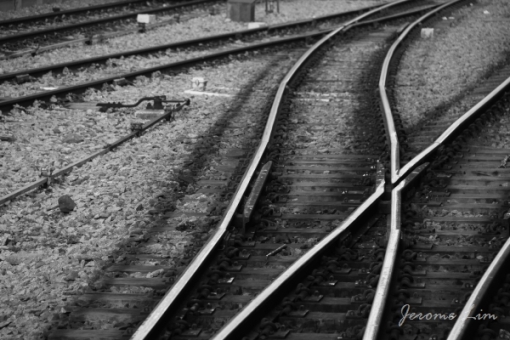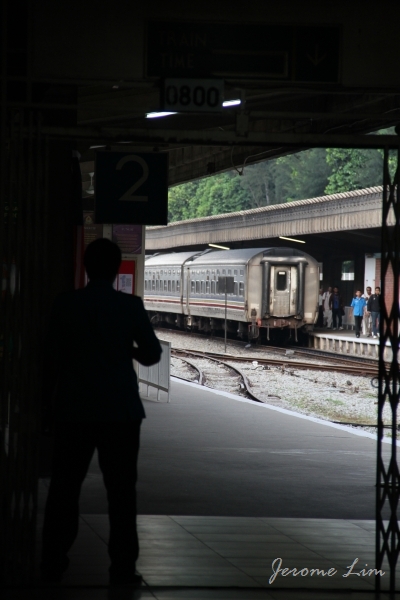Journeys through Tanjong Pagar: First Impressions …
By Jerome Lim, 21 Sep 2010.
I had as a child, been fascinated by the old railway station at Tanjong Pagar. The grand old station building, which has provided many of us with a passage to the north, had been one that always attracted my attention whenever I passed it in the backseat of my father’s car. The very first impression I have of the station is one that has been shaped by the food stalls that sprouted up in the open air car park in front of the station every evening, stalls that seemed to glow in the shadows cast by the grey façade of the railway station.



I had very much been in awe of the old grey façade, one that had appeared to be dominated by the four large statues that straddled the three large archways, each one meant to symbolise one of Malaya’s four economic pillars, with the letters FMSR, the Federated Malay States Railway, giving evidence of the time at which the station was built. The façade later drew me as it reminded me very much of the great trains stations of Europe that I had dreamt of travelling through, whilst embarking on one of the great train journeys that featured in the many black and white movies. The architecture of the station, built in 1932 had itself drawn inspiration from a great European station, Helsinki’s Central Station, and as much as Helsinki Central is a landmark in Helsinki, Tanjong Pagar Station is a landmark along Keppel Road.


Despite the fascination I had, I only visited the station on a few occasions in my childhood, each time taken by the large batik painting styled mosaic murals that adorned the high lobby of the station. It was only much later in life that I made my first journey from Tanjong Pagar, a journey that would was the start of a series of journeys by train to the Malaysian capital Kuala Lumpur (KL). That very first journey had been one that was made on a whim, with me deciding to catch an overnight train to the KL for a weekend. Arriving late after work on a Friday, I was to discover that there only third class seats on the overnight Mail Train (Mel Malam) were available. Having already made my way to Tanjong Pagar, I decided to go ahead with the journey – a decision that I was later to regret …
I had by then, developed a liking for train journeys, having first had the experience on an intercity train from Ghent to Antwerp in 1985, one that I remember for the wonderful view of the flat Flemish countryside. It was however later during my undergraduate days that I was to be able to embark on some of the great train journeys I had dreamt of in my younger years, passing through some of the magnificent stations I had longed to see: Paris’ Gare du Nord and the Gare de Lyon; London’s St. Pancreas and some of those on the Monopoly board; Santa Lucia in Venice … to name a few, each with a distinct flavour and a flamboyance that seemed fitting in their association with the great train journeys of the movies and in literature. Tanjong Pagar perhaps lacks some of the hustle that give some of the character to its European counterparts, but standing in the station that evening, I had the romantic notion that I was back in one of the great stations, embarking on another adventure on the railway.

Having waited in the lobby for a couple of hours for the gates to open, the romantic illusions I had, evaporated with the opening of the gates that led to the immigration and customs counters. The crowd that had gathered behind the gate immediately surged forward in a rush towards the counters, a rush that I hesitated to join in, deciding against jostling with the seemingly impatient crowd. Going through Immigration and Malaysian Customs, I found myself behind a wall of people held back by a steel barrier across the platform. I was soon to realise why there had been that mad initial rush. A madder rush was to follow – as soon as the barrier was pushed aside, a frenzied dash ensued – one that one might have mistaken for a dash fuelled by fear and panic. Boarding the train, it soon became apparent why the mad dash had occurred – moving up the aisle, I realised that there was not a seat left … not wanting to have to stand for what was scheduled to be a nine hour overnight journey, I searched desperately for a seat, finally finding one – a hard straight backed seat in a smoking compartment, wedged between a chain smoking passenger and a window that refused to be opened.

Somehow, I survived that long uncomfortable ride, one that was made even longer by the frequent unscheduled stops and starts the train made along the way, having to give way to the express services which shared the single track heading in both directions, and the inability to catch any sleep in the discomfort of the smoke filled cabin. The long eleven hour journey finally ended with the sight of the Kuala Lumpur’s wonderful station and with wisdom that taking the mail train to KL wasn’t as romantic as it might first have appeared to me.

Source credit: The Long and Winding Road































